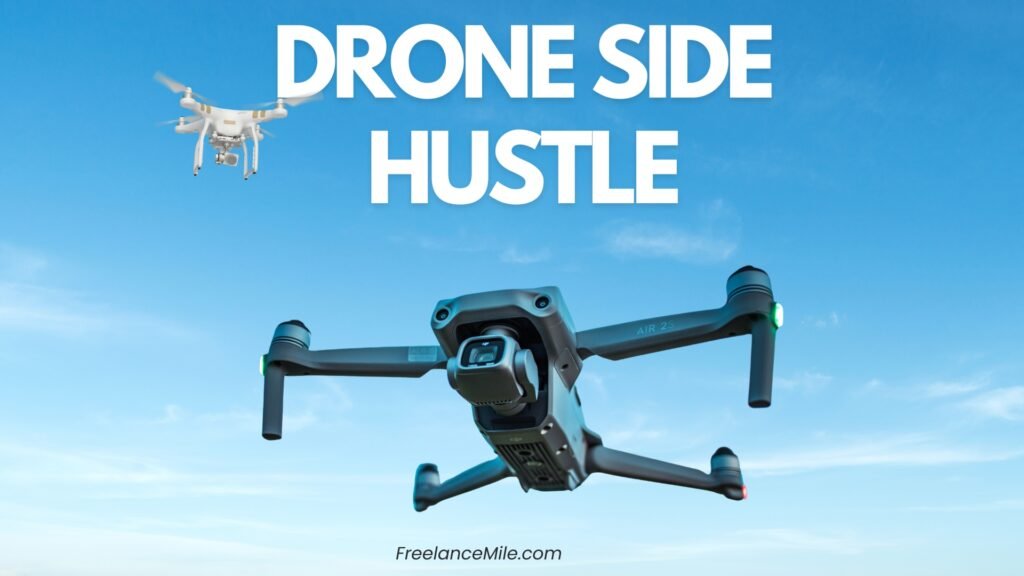Want to make money from your drone hobby? Here’s a quick tip: Try real estate photography, roof inspections, stock footage, wedding videography, aerial mapping, drone delivery, search and rescue, agricultural surveys, drone racing, social media content creation, or drone pilot training. These are 11 ways to earn from drones. Keep reading to learn more about each idea and how to start.
Drone tech has changed many industries, offering great chances for entrepreneurs. In 2025, an entry-level drone business setup typically costs between $2,500 and $5,000, including drone, insurance, and accessories.
Professional setups can range from $8,000 to $40,000 or more. Liability insurance now averages $650–$1,200 per year.
The market is set to hit $61.2 billion by 2029, making it a good choice for side hustles.
To be a commercial drone pilot, you must be 16 or older and pass the FAA’s Part 107 test. This test is easy to pass, costs $150, and lasts 2 years. After getting certified, you can find many ways to make money with drones.
Real estate agents often use drones to take beautiful aerial shots of houses. Drones help sell houses faster than traditional photos.
Key Takeaways
- Drone side hustles offer diverse income opportunities across multiple industries
- Starting a drone business requires an initial investment of $2,500 – $40,000 or more
- FAA Part 107 certification is essential for commercial drone operations
- Real estate photography is a popular and profitable niche for drone pilots
- The global drone market is predicted to grow significantly in the coming years
Drone Side Hustle Guide: 11 Income Ideas

Drones open up many side hustle options. From real estate photography to checking farms, there’s a lot you can do.
Let’s look at 11 ways you can make money with your drone skills.
1. Drone light shows for events
Drone light shows are great for festivals, concerts, and corporate events. They are becoming very popular. You need skills in programming, choreography, and drone flight rules. You’ll also need drones, control software, and lights.
Think about the show’s size and how much work it is. Talk to event planners to create shows that people love. Make sure you have the right permits and insurance for your drones.
Offering filming and behind-the-scenes footage can make you more money.
2. Creating promotional videos for businesses
Businesses want new ways to promote themselves. You can help them with aerial videos. You’ll need a good drone and video editing skills.
Offer different packages for your services. Show your best work to attract clients. Provide videos for social media to help them share your work.
3. Crop health assessment
Farmers use drones to check crop health and improve yields. You can help them by offering this service. You’ll need a drone with special cameras and software.
Learn about drones, data analysis, and farming. Charge per acre or offer packages. Work with agronomists to provide full services.
Make reports that farmers can understand. Keep up with new tech to give the best advice.
4. Land surveying and mapping
Drone surveying and mapping are in demand for construction and land development. You’ll need drone piloting and GIS skills. Invest in the right drones and software.
Price based on the area and detail needed. Get certified to attract clients. Work with construction firms for ongoing projects.
Offer 3D modeling for extra value.
5. Wildlife monitoring projects
Drone technology helps wildlife researchers and conservation groups. You can help while earning money. You’ll need drone piloting and wildlife knowledge.
Work with research groups and offer project-based pricing. Focus on certain species for specialized services. Write research papers and offer workshops to grow your impact.
6. Real Estate Photography and Videography
Real estate agents and property owners want to show their listings well. You can help them with aerial photography and videography. You’ll need a good drone and editing software to start.
Learn to fly the drone and take great photos and videos. Offer packages for different properties and editing needs. Working with real estate agencies can bring you more work.
Offer virtual tours with aerial footage and photos. This gives buyers a full view of the property. Quick service can make you stand out and help clients list their properties fast.
7. Event Coverage and Wedding Videography
Weddings and events are great for aerial shots. Drone videography adds a special touch. You’ll need skills in flying, video making, and editing.
Get a good drone and editing software. Offer packages for different events and video lengths. Add-ons like raw footage can increase your earnings.
Work with wedding planners to fit aerial footage into events. Live-streaming and same-day edits can be great extras.
8. Capturing Drone Footage for Resorts and Hotels
Resorts and hotels need great visuals to attract guests. Partner with them to make stunning aerial footage. You’ll need a good drone and editing skills.
Offer packages based on property size and amenities. Consider yearly contracts for regular updates. Virtual tours can show off properties well.
Share your work on social media and in ads. This can help resorts reach more people.
9. Selling Stock Footage
If you like taking aerial footage, selling it can be profitable. Stock footage is needed by many creators. You’ll need flying and video skills.
Get a good drone and editing software. Price your footage well, based on its quality and demand. Focus on popular subjects to sell more.
Offer exclusive licenses for more money. This can help you earn more.
10. Leverage Personal Connections
Your friends and family might need aerial services. Use your network to find work. You’ll need flying and video skills.
Offer discounted rates to your connections. Share your services on social media and through word-of-mouth. Use these projects to build your portfolio.
11. Join a Drone Provider Network (DPN)
Joining a Drone Provider Network (DPN) is a great way to find clients across many industries. These platforms have a lot of clients looking for drone pilots. You’ll need to meet the DPN’s requirements for flying drones, taking photos, and making videos.
You’ll also need a good drone with a stabilized camera and any extra gear the DPN says you need. DPNs have set rates for different projects. Make sure these rates fit your costs and what you want to make.
To get more clients, keep a high rating and good reviews by doing great work and being nice to customers. Be quick to answer and professional in your talks with clients. Keep your skills and gear up to date to stand out.
Looking into these drone side hustles and thinking about market demand, skills, gear, and prices can make your drone passion profitable. You can specialize or offer many services. The drone industry is growing, giving you many chances to show your skills and creativity and make money.
Introduction to Drone Side Hustles
Drone technology has grown fast, offering new chances for entrepreneurs. The market is set to hit $61.2 billion by 2029. This is a great time to start your own drone business.
The Rising Popularity of Drone Technology
The FAA says over 855,860 drones are registered in the US, with 37% for work. Drones are used in many areas, like real estate and farming. This means there are many ways for skilled pilots to make money.
Benefits of Starting a Drone-Based Business
Starting a drone business has many perks. You can work when you want and make money from what you love. You can offer services like aerial footage, videography, or drone operations, fitting your skills to what people need.
Overview of Potential Income Opportunities
Drone jobs can pay well. Here’s what you might earn in different fields:
| Service Type | Typical Rate (2025) |
|---|---|
| Real Estate Photography | $85–$275/hour or $300–$400/project |
| Roof Inspections | $150–$400/project |
| Wedding/Event Videography | $500–$2,000/event |
| Agricultural Surveying | $10–$25/acre |
| Stock Footage (per clip) | $50–$500 |
| Drone Light Shows | $10,000–$50,000/show (multi-drone) |
| Freelance Drone Pilot | $50–$90/hour (average: $62/hr) |
Hourly pay depends on your experience. If you love drones, there’s a spot for you in videography, drone operation, or commercial drone piloting.
Drone Pilot Training and Education
Becoming a skilled drone pilot takes hard work and the right training. You must learn many skills and know how to use drones like the DJI Phantom and DJI Mini. Let’s look at what you need to know for drone pilot education.
First, getting a remote pilot certificate is key. This shows you know about flying drones safely and following the rules. Many colleges now have programs in Unmanned Aircraft Systems Operations. These programs give you a deep understanding of drones.
Practical skills are also vital. Improve your drone flying skills by practicing a lot. Learn to take amazing aerial photos and edit photos and videos well. These skills will make you stand out in the drone world.
Education is the key to unlocking the full potential of drone technology in various industries.
Here’s what you need to know as a drone pilot:
- Drone flight skills
- Taking aerial photos and videos
- Editing photos and videos
- Knowing the rules of the sky
- Following safety rules and assessing risks
| Skill | Importance | Training Method |
| Drone Operation | High | Hands-on practice, flight simulators |
| Photography/Videography | High | Online courses, field practice |
| Editing Software | Medium | Tutorial videos, workshops |
| Regulations Knowledge | High | FAA study materials, prep courses |
It’s important to keep learning in this fast-changing field. Keep up with new drone tech and trends to stay ahead.
Legal Considerations and Licensing
Starting a drone side hustle means you have to follow the law. The Federal Aviation Administration (FAA) is in command of drones in the U.S. It’s key to know their rules to do well.
FAA Part 107 Certification
You must have FAA Part 107 certification to fly drones for work. This license costs $150 and lasts for two years. The test is easy, with a high pass rate, making it open to many.
Insurance Requirements
Drone insurance is a must to protect your business. You should get liability coverage for accidents and damage. Also, make sure your drone is covered.
Local Regulations and Airspace Restrictions
Know the local laws and airspace rules where you fly. Use tools like Airmap to check if flying is okay. Following the rules keeps your drone business legal and growing.
| Requirement | Details | Cost |
| FAA Part 107 Certification | Valid for 2 years, high pass rate | $150 |
| Liability Insurance | Covers accidents and property damage | $600-$1,000/year |
| Hull Insurance | Protects drone equipment | $500-$750/year |
As of 2025, the FAA Part 107 certification is still required for commercial drone pilots, but renewal is now every three years (previously two). All drones over 0.55 lbs must broadcast Remote ID information when flying.
The FAA is also piloting expanded Beyond Visual Line of Sight (BVLOS) waivers, opening new opportunities for delivery and infrastructure inspection.
Challenges and Solutions for a Drone Side Hustle
Starting a drone side hustle is rewarding but has challenges. Here are some key challenges and solutions to help you:
Challenges
- Regulatory Compliance:
- Challenge: Understanding and following drone laws in your area.
- Solution:
- Learn the drone laws in your area.
- Get the right permits, like a Part 107 pilot certificate from the FAA (in the United States).
- Keep up with any law changes.
- Initial Investment:
- Challenge: The cost of buying a drone and accessories.
- Solution:
- Start with a mid-range drone that is good and affordable.
- Think about renting or leasing if you can’t afford to buy.
- Look for deals on drones and accessories.
- Skill Development:
- Challenge: Learning to fly a drone safely and well.
- Solution:
- Take drone pilot training courses.
- Practice flying in a safe place.
- Watch tutorials and learn from others.
- Weather Conditions:
- Challenge: Weather that makes flying hard.
- Solution:
- Check the weather before flying.
- Buy drones and gear that can handle bad weather.
- Have plans for bad weather.
- Competition:
- Challenge: Other drone operators in your area.
- Solution:
- Focus on a special area, like real estate photos or aerial inspections.
- Offer something different to stand out.
- Build good relationships with clients.
- Insurance:
- Challenge: Needing insurance for your drone work.
- Solution:
- Find the right insurance for your drone work.
- Think about liability insurance for damages or injuries.
More Solutions
- Start Small and Scale: Start with small projects and grow as you get more experience and clients.
- Network with Other Drone Pilots: Talk to other drone pilots to share tips, resources, and ideas.
- Leverage Social Media: Use social media to show your work, find clients, and build your brand.
- Offer Additional Services: Offer extra services, like video editing or photography, to make more money.
- Continuous Learning: Keep up with new drone tech, laws, and trends to stay ahead.
Think about these challenges and solutions to increase your chances of success in your drone side hustle.
FAQ
How low can you fly a drone over private property?
In the USA, you can legally fly a drone over private property as low as necessary, provided you stay below 400 feet and maintain visual line of sight. However, it’s advisable to obtain permission from property owners to avoid potential privacy violations and trespassing issues.
What are the most common mistakes to avoid in a drone side hustle?
Common mistakes in a drone side hustle include neglecting to understand and comply with FAA regulations, failing to maintain proper insurance coverage, and not investing in quality equipment. Additionally, overlooking pre-flight checks and not managing client expectations can lead to operational failures and dissatisfaction.
What are the essential tools and equipment for a drone side hustle?
Essential tools for a drone side hustle include a reliable drone equipped with a high-quality camera, spare batteries, a drone maintenance kit, and software for flight planning and data analysis. Additionally, having insurance, a good laptop or tablet for editing, and a solid marketing strategy are crucial for success.
What qualifications or certifications are required to legally fly a drone over private property in the USA?
To legally fly a drone for commercial purposes over private property in the USA, you need a Remote Pilot Certificate granted by the FAA, which requires passing a knowledge test. This certification ensures you understand airspace regulations and safe operational practices.
How do weather conditions impact the legality and safety of flying a drone over private property?
Weather conditions significantly impact drone operations; poor visibility, strong winds, and precipitation can compromise safety and legality. For example, flying in heavy rain or high winds can damage the drone and make it difficult to maintain control, potentially leading to accidents and legal issues if unable to comply with regulations.
Conclusion and Future Predictions
The drone industry is growing fast, offering great chances for side jobs and full-time work. Over 60% of drones are used for taking photos and videos from the air. This shows how much potential there is in this field.
Drone technology is getting better every year, thanks to AI and learning machines. This means your drone side job could grow into something bigger and more profitable. For example, drones are now 40% more efficient in farming by monitoring crops and spraying them.
In the future, drones will change the way we move around cities and connect with the internet. They could make city travel 60% better and improve drone internet by 35%. As a drone business owner, keeping up with these changes is crucial. Freelance drone pilots make about $47.71 an hour, showing how your side job could turn into a big business.







